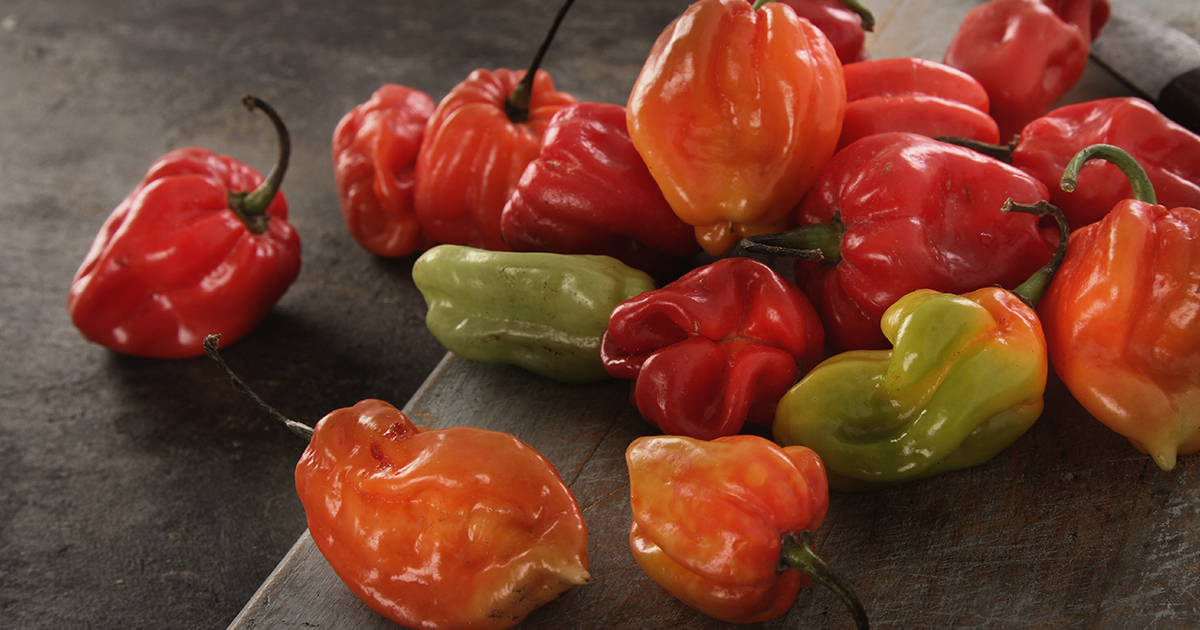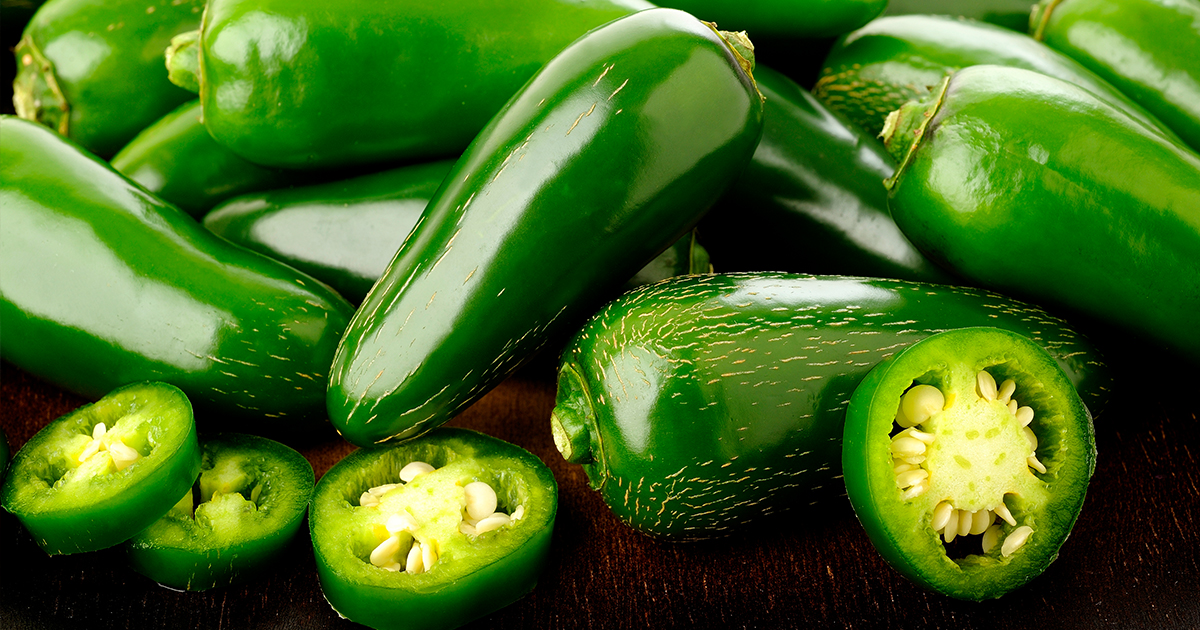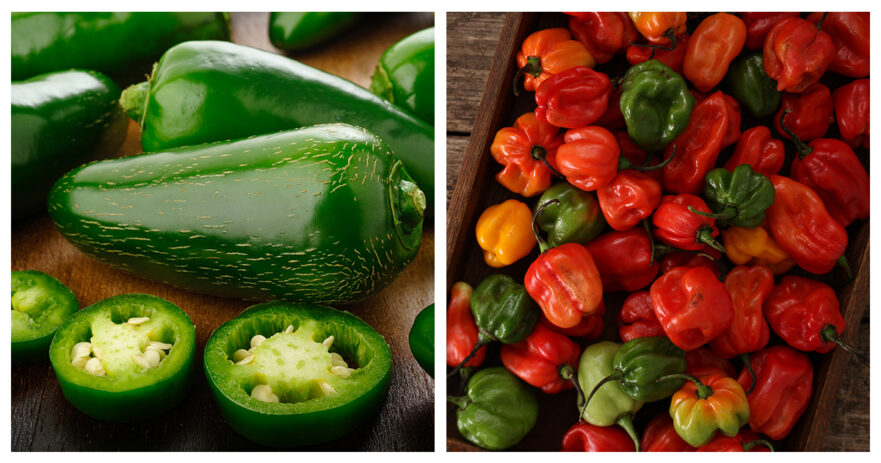Across the globe, peppers have become a staple ingredient in countless culinary traditions. These peppers come in a wide range of flavors and heat levels, which makes them versatile ingredients that can be used in a myriad of ways. Among these peppers are the Scotch Bonnet and Jalapeño peppers, two types of chili peppers that have gained popularity in different cuisines. Today, we‘ll explore the various differences between Scotch Bonnet and Jalapeño peppers so that you can feel comfortable picking the perfect pepper for whatever you’re cooking.
| Scotch bonnet | Jalapeño pepper | |
| SHU | 100,000 - 350,000 | 2,500 - 8,000 |
| Median SHU | 225,000 | 5,250 |
| Flavor | Sweet, fruity, tropical, citrusy | Grassy, vegetale, slightly sweet, and moderately spicy |
| Species | Capsicum chinense | Capsicum annuum |
| Origin | South America | Mexico |
| Uses | Sauces, dry rubs, marinades, salsas, soups, curries | Salsas, guacamole, nachos, jalapeño poppers, etc. |
Table of contents
What are Scotch Bonnet Peppers?

Scotch Bonnet peppers are a really neat type of chili pepper that are huge in Caribbean cuisine. They‘re known for their incredibly unique flavor, combining sweetness and spiciness. These guys are small and round, with a bright, wrinkled skin that‘s usually found in yellow, orange, or red. Scotch Bonnet peppers have a Scoville rating of 100,000 to 350,000, which is about the same as habaneros. This makes them one of the hottest chili peppers in the world.
The origin of the Scotch Bonnet can be traced back to the Caribbean islands, where it‘s been an integral part of the local cuisine for several centuries. These hot little peppers are used in a wide range of dishes, from jerk chicken, curries, and stews to sauces, marinades, and chutneys.
Scotch Bonnet peppers have been known to be a little more challenging to grow than other varieties of pepper because they require pretty specific growing conditions. They thrive in warm, sunny climates and require well-draining soil that is rich in organic matter. The plants can easily grow up to three to four feet tall and need regular pruning to ensure maximum pepper yield. Scotch Bonnets are often grown in greenhouses or warm countries where they can be cultivated year-round.
Despite their intense heat, Scotch Bonnet peppers are beloved by many for their unique flavor profile. They‘re a key ingredient in Caribbean cuisine and have gained popularity in other parts of the world as well. With their fruity, sweet taste and fiery heat, Scotch Bonnet peppers are a true culinary gem that are cherished by chefs and food lovers alike.
What are Jalapeño peppers?

Jalapeño peppers are a wildly popular chili pepper variety that first popped up in Mexico. These peppers are beloved for their distinctive spicy and grassy flavor, as well as their ability to be used in multiple types of cuisines. They‘re small to medium-sized, with smooth and shiny skin that’s a nice shade of deep green. Jalapeños have a Scoville rating of 2,500 to 8,000, meaning they‘re much milder than Scotch Bonnet peppers.
Jalapeño peppers can be found in a variety of dishes and cuisines. They’re quite often used in things like sauces and meat-based dishes, like salsas and tacos. They also are popular as pizza toppings, as well as being pickled and plopped on top of burgers for extra flavor. Jalapeños make for a great addition to any kind of meal, bringing on the heat without killing off the other flavors.
Jalapeño plants are are popular among home gardeners because they’re easy enough to grow. With well-draining soil and plenty of sunlight, jalapeño plants can grow up to two or three feet tall, producing fantastic peppers all growing season.
Jalapeño peppers are incredibly easy to use in all kinds of cuisines. They can add a distinctive kick to whatever you toss them into. Whether you prefer them fresh, pickled, or in a sauce, Jalapeño peppers are a must-have ingredient for any home cook or chef looking to add some heat to their dishes.
What are the differences between Scotch Bonnet and Jalapeño peppers?
Scotch Bonnet peppers are known for their smaller, rounder shape resembling the Scottish Tam o’Shanter hat, while Jalapeños are slightly larger and more elongated. The bright and wrinkled skin of Scotch Bonnets can range from yellow to orange to red, whereas Jalapeños have smooth green skin that turns red as they mature.
Scotch Bonnet peppers pack a fiery punch with a Scoville rating of 100,000 to 350,000, making them some of the hottest chili peppers in the world. In comparison, Jalapeños are considered a milder pepper with a Scoville rating of 2,500 to 8,000.
These two types of peppers have distinct taste profiles that distinguish them from one another. While the Scotch Bonnet has a fruity and sweet flavor reminiscent of the habanero, the Jalapeño has a more grassy and earthy flavor with a subtle sweetness.
Scotch Bonnet and Jalapeño peppers are versatile ingredients in a range of cuisines worldwide, with a particular prominence in Latin American and Caribbean cooking. In spicy stews, curries, and hot sauces, Scotch Bonnet peppers are frequently employed. Jalapeños, on the other hand, are commonly used in salsas, pickled vegetables, and as a topping for nachos and other Mexican dishes.
Scotch Bonnet peppers are a bit more challenging to cultivate compared to Jalapeños, as they require a longer growing season and warmer weather. These peppers thrive in full sun, well-draining soil, and need protection from strong winds. On the other hand, Jalapeño plants are more versatile and can be grown in different climates and soils.
What are the similarities between Scotch Bonnet and Jalapeño peppers?
Both types of peppers are widely used in Latin American and Caribbean cuisine, with Scotch Bonnet peppers commonly used in stews, curries, and hot sauces, while Jalapeños are often used in salsas, pickled vegetables, and as a topping for tacos and other Mexican dishes.
Both Scotch Bonnet and Jalapeño peppers have unique flavor profiles that add depth to dishes. Both peppers have gained worldwide popularity, and many chefs and home cooks use them in their recipes.
Preparing both types of peppers involves cutting off the stem and slicing the pepper open to remove the seeds and membranes, which reduces the heat level. Once prepared, the peppers can be sliced or diced and added to a wide variety of dishes, from appetizers and snacks to main courses and condiments.
FAQ about Scotch Bonnet and Jalapeño
What‘s the difference between Scotch Bonnet and Jalapeño peppers?
Scotch Bonnet and Jalapeño peppers are two types of chili peppers that differ in heat intensity, flavor profile, and culinary uses. Scotch Bonnet peppers are smaller and rounder, with wrinkled skin that is usually yellow, orange, or red, and are considered to be one of the hottest chili peppers in the world. Jalapeño peppers are larger and more elongated, with a smooth green skin that turns red as they mature, and are considered a milder pepper.
How spicy are Scotch Bonnet and Jalapeño peppers?
Scotch Bonnet peppers are one of the hottest chili peppers in the world, with a Scoville rating of 100,000 to 350,000. Jalapeño peppers, on the other hand, have a Scoville rating of 2,500 to 8,000, making them considerably milder than Scotch Bonnet peppers.
What‘s the flavor profile of Scotch Bonnet and Jalapeño peppers like?
Scotch Bonnet peppers have a pretty cool flavor that‘s a combination of sweet and spicy, a lot like the habanero pepper. Jalapeño peppers, on the other hand, have a distinctive spicy flavor with a subtle sweetness and a grassy, earthy undertone.
What are the culinary uses of Scotch Bonnet and Jalapeño peppers?
Scotch Bonnet peppers are a staple ingredient in Caribbean cuisine and are used in a wide range of dishes, such as jerk chicken, chutneys, and stew. Jalapeño peppers get used in a variety of dishes across many cuisines. They‘re often used in different sauces or as toppings for all sorts of things.
Can Scotch Bonnet and Jalapeño peppers be substituted for one another in recipes?
We don’t really recommend substituting Scotch Bonnet and Jalapeño peppers for one another, as they’re pretty different in terms of heat intensity and flavor profile.

